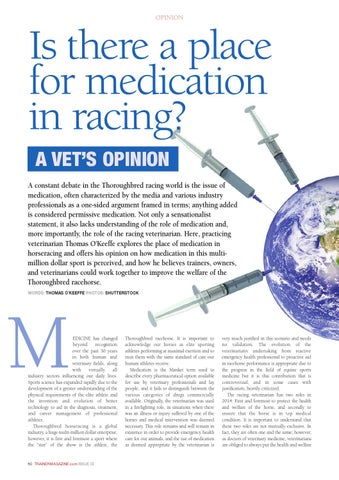OPINION
Is there a place for medication in racing? A VET’S OPINION A constant debate in the Thoroughbred racing world is the issue of medication, often characterized by the media and various industry professionals as a one-sided argument framed in terms; anything added is considered permissive medication. Not only a sensationalist statement, it also lacks understanding of the role of medication and, more importantly, the role of the racing veterinarian. Here, practicing veterinarian Thomas O’Keeffe explores the place of medication in horseracing and offers his opinion on how medication in this multimillion dollar sport is perceived, and how he believes trainers, owners, and veterinarians could work together to improve the welfare of the Thoroughbred racehorse. WORDS: THOMAS O’KEEFFE PHOTOS: SHuTTERSTOcK
M
EDICINE has changed beyond recognition over the past 30 years in both human and veterinary fields, along with virtually all industry sectors influencing our daily lives. Sports science has expanded rapidly due to the development of a greater understanding of the physical requirements of the elite athlete and the invention and evolution of better technology to aid in the diagnosis, treatment, and career management of professional athletes. Thoroughbred horseracing is a global industry, a huge multi-million dollar enterprise; however, it is first and foremost a sport where the “star” of the show is the athlete, the
50 TRAINERMAGAZINE.com ISSUE 33
Thoroughbred racehorse. It is important to acknowledge our horses as elite sporting athletes performing at maximal exertion and to treat them with the same standard of care our human athletes receive. Medication is the blanket term used to describe every pharmaceutical option available for use by veterinary professionals and lay people, and it fails to distinguish between the various categories of drugs commercially available. Originally, the veterinarian was used in a firefighting role, in situations when there was an illness or injury suffered by one of the horses and medical intervention was deemed necessary. This role remains and will remain in existence in order to provide emergency health care for our animals, and the use of medication as deemed appropriate by the veterinarian is
very much justified in this scenario and needs no validation. The evolution of the veterinarian’s undertaking from reactive emergency health professional to proactive aid in racehorse performance is appropriate due to the progress in the field of equine sports medicine but it is this contribution that is controversial, and in some cases with justification, heavily criticized. The racing veterinarian has two roles in 2014: First and foremost to protect the health and welfare of the horse, and secondly to ensure that the horse is in top medical condition. It is important to understand that these two roles are not mutually exclusive. In fact, they are often one and the same; however, as doctors of veterinary medicine, veterinarians are obliged to always put the health and welfare
